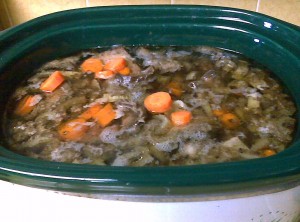 Bone broths are an important element of traditional cuisines. They are the basis of wonderful sauces, soups, and gravies.
Bone broths are an important element of traditional cuisines. They are the basis of wonderful sauces, soups, and gravies.
Bone broth is a great way to get the nutrients needed for healthy bones and joints in an easily absorbable form. Bone broth is rich in glycosaminoglycans, glucosamine, calcium, magnesium, and potassium—basically a total bone- and joint-building package. The gelatin in bone broths can be used to treat many intestinal disorders such as colitis and Crohn’s disease. The amino acids in broth act as a tonic for the bowel wall. Bone broth helps the liver cleanse itself from the residues of metabolism.
Bone Broth Recipe
The following fits well in my oval Crock-Pot. Scale the recipe to fit your pot.
I give bone broth to my dog, too, so I don’t use onions in the broth. You can add an onion if you will not be feeding the finished stock to a dog. Do NOT feed the cooked bones to your pet. They will be too soft and may break into pieces. Seriously, feeding soft bones to your dog can result in intestinal blockage that could potentially kill your dog.
I have included directions for three methods: electric pressure cooker, stove top, and slow cooker. According to the Serious Eats Food Lab, the pressure cooker method yielded the best results followed closely by the stove top method.
Ingredients
4 lb. raw bones with or without skin and/or meat
8 cups water
½ cups apple cider vinegar
2 carrots
2 stalks celery
Directions (electric pressure cooker)
- Add your choice of bones into pressure cooker. Cover the bones with cold water just until covered; or 2 cups of water per 1 pound of bones. DO NOT FILL MORE THAN 2/3 FULL! Add 2 tablespoons of cider vinegar per 1 pound of bones. Let stand for one hour.
- Set pressure cooker to high for 2 hours for chicken bones or 4 hours for beef bones. If you are using a stove top pressure cooker, you will need to monitor it closely the entire time.
- After the broth is cooked, let the pressure release naturally.
- Bones will become soft when touched by a fork.
- Strain broth through a colander or sieve lined with cheesecloth or paper towel. Discard bones.
- Cool broth in the refrigerator for several hours. The fat can then be removed rendered for use in cooking.
Directions (stove top)
- Add your choice of bones into a large pot. Cover the bones with cold water just until covered; or 2 cups of water per 1 pound of bones. Add 2 tablespoons of cider vinegar per 1 pound of bones. Let stand for one hour.
- Bring to a low boil. Remove any scum that has risen to the top,
- Reduce heat. Let simmer for 6 to 48 hours for chicken bones or 12 to 72 hours for beef bones. Bones will become soft when touched by a fork.
- Strain broth through a colander or sieve lined with cheesecloth or paper towel. Discard bones.
- Cool broth in the refrigerator for several hours. The fat can then be removed rendered for use in cooking.
Directions (slow cooker)
- Add your choice of bones into a slow cooker. Cover the bones with cold water just until covered; or 2 cups of water per 1 pound of bones. Add 2 tablespoons of cider vinegar per 1 pound of bones. Let stand for one hour.
- Set the slow cooker for high heat and bring to a boil. Remove any scum that has risen to the top,
- Set the slow cooker for low heat. Let simmer for 6 to 48 hours for chicken bones or 12 to 72 hours for beef bones. Bones will become soft when touched by a fork.
- Strain broth through a colander or sieve lined with cheesecloth or paper towel. Discard bones. You can also cook bone broth in a crock-pot. Low heat.
- Cool broth in the refrigerator for several hours. The fat can then be removed rendered for use in cooking.
Sally Fallon on Bone Broth:
How To Make Beef Stock:
References:
Mary Enig, Sally Fallon. Eat Fat, Lose Fat: The Healthy Alternative to Trans Fats. Plume (March 28, 2006).
Catherine Shanahan, Luke Shanahan. Deep Nutrition: Why Your Genes Need Traditional Food. Big Box Books (November 14, 2008).